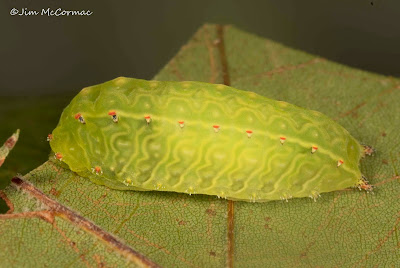I reported on last weekend's great caterpillar safari in my last post, but showed few caterpillar photos. I will atone for that here. Our group found at least four dozen species, and I photographed a fair chunk of them.
Caterpillaring becomes addictive. Taken to extremes, it LOOKS LIKE THIS. I've been at the larval game for some time, and love the thrill of the hunt. Caterpillars do not want to be seen, and the vast majority of species are nocturnal, the better to avoid diurnal songbirds and insect predators. That means the successful hunter must also be active after dark, and that's when most of the subjects of this post were found. Throw in the allure of photography, the challenge of nightime shooting, and the novelty of charismatic subjects that few people photograph, and it's hard to beat.
More importantly, learning about caterpillars helps one learn MUCH more about food webs and ecosystems. Caterpillars are tube steaks on legs; Nature's hotdogs. It seems like everything eats them, and caterpillars are such a huge staple in the diet of many species of birds that we'd lose these songsters without the larvae. Some experts feel that the mortality rate of many caterpillar species is well over 90%. In other words, almost all of them are eaten. Those that make it become butterflies or moths, mate, lay eggs, and carry on the species.
Driving it all is native plants. Our caterpillars are chemically finicky and generally shun nonnative flora, with which they have no real co-evolutionary history. This is yet another reason to plant natives. You'll be growing crops of caterpillars, and feeding the higher-ups on the food chain.
A pair of common buckeye caterpillars, Junonia coenia, nosh on slender foxglove, Agalinis tenuifolia. If they make it, they will morph into one of our most beautiful butterflies. The overwhelming majority of caterpillars are those of moths. Around 2,000 species of moths have thus far been documented in Ohio (some authorities believe MANY others await documentation), while we've only tallied about 140 butterfly species.
The leaf of a sycamore, Platanus occidentalis. An obligate sycamore feeder sits prominently on the leaf. Or perhaps not so prominently. Caterpillars are masters of disguise, or at least many of them are.
A closer view of the caterpillar in the previous photo. It is a drab prominent, Misogada unicolor, which insofar as I know feeds only on sycamore. The pale stripe on its back mimics the pale midribs of sycamore leaves remarkably well. Go look at the previous image. By the way, sometimes the English names of moths are derived from the adult moth, sometimes the caterpillar. There's nothing "drab" about this larva; the name stems from the bland appearance of the moth.
This was a great find, by, I believe, Ann Geise (someone who was there correct me if I'm wrong). It's a hitched arches, Melanchra adjuncta. These caterpillars are often found in fairly conspicuous spots during the day, and that's when this one turned up. It is on water hempweed, Amaranthus tuberculatus, which the cat matches quite well.
An amazing bag of goo, this one, and always a crowd-pleaser. A specialist in the extreme, this honey locust moth, Syssphinx bicolor, feeds only on its namesake tree, Gleditsia triacanthos.
One of many oak specialists, this orange-striped oakworm, Anisota senatoria, is feeding on a black oak leaf, Quercus velutina. Oaks support more species of caterpillars than any other floristic group, by a long shot. Their conservation is vital to the ecology of the great eastern deciduous forest.
The slug moth caterpillars are often otherworldly in appearance, often looking like sea slugs plucked from a coral reef. This is a Nason's slug, Natada nasoni. Note the pale vermiculations (squiggles) on its body. Unlike the specialist caterpillars, this one is polyphagous - it eats many species of plants.
Hard to top the exoticness of a purple-crested slug, Adoneta spinuloides. How could you miss this thing, one might think. Like most slug moth cats, it is tiny, maybe a half-inch in length, and quite easy to overlook. We often employ ultra-violet flashlights in our quest. Many caterpillars, including most slugs, glow brightly under such beams.
I was quite pleased to see this species, and this individual was one of at least three found during the weekend. Chris and Sue Zacharias found two on white pine (which is not native in this region), and Randy Lakes found this specimen on native Virginia pine, Pinus virginiana. It's the aptly named pine sphinx, Lapara coniferarum, and it was new for nearly everyone including me.
Thanks to everyone who joined the hunt last weekend! I look forward to the 2020 expedition.









